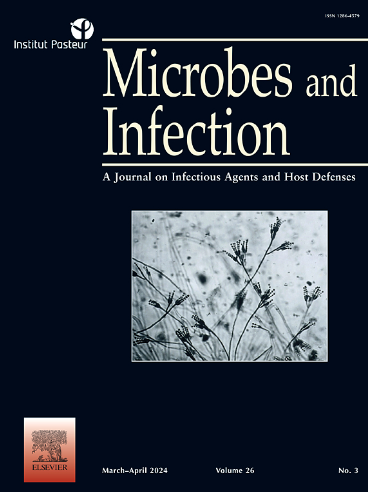Loss of cilia in chemosensory neurons inhibits pathogen avoidance in Caenorhabditis elegans
IF 2.6
4区 医学
Q3 IMMUNOLOGY
引用次数: 0
Abstract
Pathogen avoidance is a crucial and evolutionarily conserved behavior that enhances survival by preventing infection in diverse species, including Caenorhabditis elegans (C. elegans). This behavior relies on multiple chemosensory neurons equipped with cilia that are exposed to the external environment. However, the specific role of neuronal cilia in pathogen avoidance has not been completely elucidated. Herein, we discovered that osm-3(p802) mutants, which lack chemosensory neuronal cilia, exhibit slower avoidance of the pathogen Pseudomonas aeruginosa PA14, but not Escherichia coli OP50. This observation was consistent when osm-3(p802) mutants were exposed to P. aeruginosa PAO1. Following an encounter with PA14, the pumping, thrashing, and defecation behaviors of osm-3 mutants were comparable to those of the wild-type. However, the osm-3 mutants demonstrated reduced intestinal colonization of PA14, suggesting that they have stronger intestinal clearance ability. We conducted RNA-seq to identify genes responding to external stimuli that were differentially expressed owing to the loss of osm-3 and PA14 infection. Using RNAi, we demonstrated that three of these genes were essential for normal pathogen avoidance. In conclusion, our findings demonstrate that the loss of chemosensory neuronal cilia reduces pathogen avoidance in C. elegans while delaying intestinal colonization.
化感神经元中纤毛的缺失会抑制秀丽隐杆线虫的病原体规避能力
病原体回避是一种关键且进化保守的行为,它通过防止感染来提高包括秀丽隐杆线虫(C. elegans)在内的不同物种的存活率。这种行为依赖于多个配备纤毛的化感神经元,这些纤毛暴露在外部环境中。然而,神经元纤毛在病原体回避中的具体作用尚未完全阐明。在这里,我们发现缺乏化感神经元纤毛的osm-3(p802)突变体对病原体铜绿假单胞菌 PA14 的回避速度较慢,但对大肠杆菌 OP50 的回避速度却不慢。当 osm-3(p802) 突变体暴露于铜绿假单胞菌 PAO1 时,这一观察结果是一致的。接触 PA14 后,锇-3 突变体的抽吸、激动和排便行为与野生型相当。然而,osm-3突变体的肠道定植PA14的情况有所减少,这表明它们具有更强的肠道清除能力。我们进行了RNA-seq分析,以确定因osm-3缺失和PA14感染而出现差异表达的响应外部刺激的基因。利用 RNAi 技术,我们证明了其中三个基因对于正常的病原体回避是必不可少的。总之,我们的研究结果表明,化感神经元纤毛的缺失会降低秀丽隐杆线虫的病原体回避能力,同时延缓肠道定植和扩张。
本文章由计算机程序翻译,如有差异,请以英文原文为准。
求助全文
约1分钟内获得全文
求助全文
来源期刊

Microbes and Infection
医学-病毒学
CiteScore
12.60
自引率
1.70%
发文量
90
审稿时长
40 days
期刊介绍:
Microbes and Infection publishes 10 peer-reviewed issues per year in all fields of infection and immunity, covering the different levels of host-microbe interactions, and in particular:
the molecular biology and cell biology of the crosstalk between hosts (human and model organisms) and microbes (viruses, bacteria, parasites and fungi), including molecular virulence and evasion mechanisms.
the immune response to infection, including pathogenesis and host susceptibility.
emerging human infectious diseases.
systems immunology.
molecular epidemiology/genetics of host pathogen interactions.
microbiota and host "interactions".
vaccine development, including novel strategies and adjuvants.
Clinical studies, accounts of clinical trials and biomarker studies in infectious diseases are within the scope of the journal.
Microbes and Infection publishes articles on human pathogens or pathogens of model systems. However, articles on other microbes can be published if they contribute to our understanding of basic mechanisms of host-pathogen interactions. Purely descriptive and preliminary studies are discouraged.
 求助内容:
求助内容: 应助结果提醒方式:
应助结果提醒方式:


